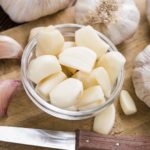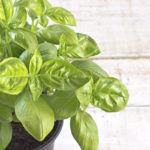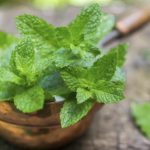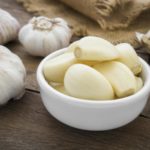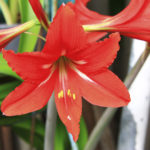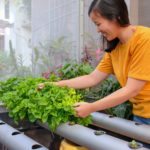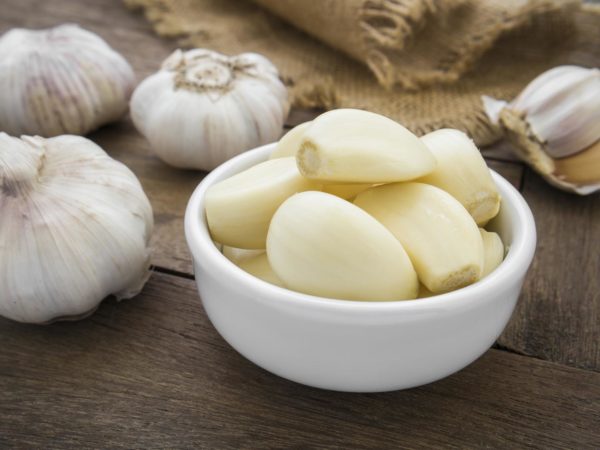
Garlic is repulsive. I love it. I love to cook with it and I love to grow it. I love its botanical name, allium sativum. Our English word, garlic, comes from Old English, meaning literally “spear leek.” A member of the lily family, it is related to the onion.
Between the annals of medicine and the culinary traditions of the world, its merits are well documented. No cuisine I know omits garlic, and no doctor holds it in higher regard than does Dr. Weil. Garlic, the wonder root, the bane of the lunch meeting and the first kiss, with its medieval odor and all of its popular lore, is a true soldier in the fight against evil. If you read enough of Dr. Weil you might think a diet of dark chocolate and garlic might be sufficient to sustain your body. Alas, ajo con cocoa sounds almost as appetizing as instant-pizza-in-a-cup.
You’ve probably inadvertently grown garlic on your kitchen counter. Because garlic is a bulb, it will either send out shoots or, if dead, dry out or rot. Soft (which indicates decay) garlic cloves shouldn’t be used, but sprouted bulbs are still fine for cooking. Depending on the time of year, you can also stick a clove in fertile soil and it just might grow into a head. The initial bulb will provide energy for the first leaves and roots, which will in turn grow clove by clove around this central axis, each green sprout representing a new clove.
There are two types of garlic, softneck and hardneck. Softneck varieties are grown in milder climates with longer days; hardnecks are grown in cooler, northern climates. I believe most commercially produced garlic is of the softneck variety. Softnecks grow in a uniform circle around the center, while hardnecks spiral from the center. If you want to grow garlic and can’t find the variety you need, you can order garlic through many of the seed companies such as Territorial Seed or a specialty grower. The numerous varieties may surprise you: walking garlic, a tasty novelty plant, grows bulbs at the end of its green stalk as opposed to in the root zone.
Garlic likes a loose, well-drained soil with plenty of nitrogen. To prepare the bed, I fork in a couple inches of compost or organic composted mulch. In the past, I have added a small amount of blood meal. As an experiment, I didn’t use any blood meal this year, but the gophers got most of my plants. Blood meal is basically a slow-release source of nitrogen and, apparently, a gopher repellent, but I encourage you to find alternatives if possible. An organic, vegetarian, root-crop fertilizer such as Root Crops Alive! might be worth trying.
Once your soil is prepared, it’s time to plant the cloves. One head generally has six to ten cloves. I usually buy a couple of extra heads and choose the biggest cloves to plant. Each clove should be planted about six inches apart. The dibble, a tapered, pointed tool, can be used to poke holes in the soil or you can use a trowel or your fingers. One clove should be planted about four inches deep with the rough (root) end down and the pointed end up. Firm contact with the soil will assure good root development. I make a bunch of holes, plant the cloves and then cover them loosely with two inches of soil. On top of the soil, I place another couple of inches of compost and then I water.
Garlic doesn’t need a lot of water. In a good year in the desert our winter rains provide most of the water. I plant my garlic at the end of the hot summer, sometime in early October, and harvest in May. In colder climates, garlic can be planted in spring, when the ground has thawed enough to work.
At the end of the season, garlic will attempt to complete its life cycle by producing a scape and umbel; that is, a stalk and flower. Pulling off the scape and umbel will encourage plumper bulbs, as the plant will not put energy into the flower and seed cycle. Harvest with a fork to avoid damaging the heads.
Garlic is good for everybody. If you ever visit Dr. Weil’s ranch, you’ll certainly be greeted by Daisy, one of his two Rhodesian Ridgebacks. If she’s just eaten, you’ll notice her dog breath is overpowered by garlic. A little sprinkle of garlic powder on her food is good for her health and is supposed to ward off fleas. Garlic can keep pests out of the garden, whether as a companion plant or juiced and used as a spray. The uses and properties of garlic are quite extensive, and though space isn’t permitted here to expound on its many virtues, I encourage you to grow your own.
By Jace Mortensen, Guest Commentator
DrWeil.com News


